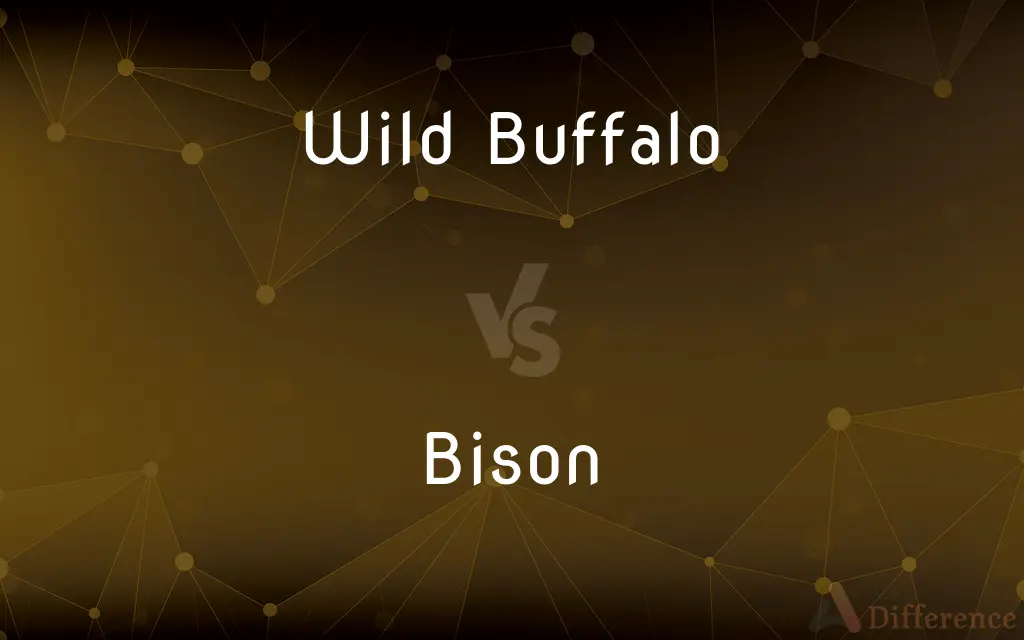Wild Buffalo vs. Bison — What's the Difference?
Edited by Tayyaba Rehman — By Fiza Rafique — Published on December 12, 2023
Wild Buffalo refers to large bovines native to Asia and Africa, while Bison are large bovines indigenous to North America and Europe.

Difference Between Wild Buffalo and Bison
Table of Contents
ADVERTISEMENT
Key Differences
Wild Buffalo, predominantly found in Asia and Africa, are integral to their ecosystems and are known for their broad, backward-curving horns. In contrast, Bison, native to North America and Europe, have a massive head, a humped shoulder, and shorter, sharper horns. Both creatures play essential roles in their respective environments but have distinct evolutionary histories and physical differences.
African buffalos, for instance, are found across various habitats in Africa, from savannas to swamps. They are known for their unpredictable nature and are one of the 'Big Five' game species. On the other side, the American Bison, often referred to as buffalo mistakenly in the U.S., once roamed North America's grasslands in vast herds, playing a vital role in the prairie ecosystem.
One significant distinction between Wild Buffalo and Bison is their relationship with humans. Wild Buffalos have been integral to several Asian and African cultures for their utility in agriculture and as a source of food. Bison, especially in North America, were central to the indigenous tribes' cultures, being used for food, shelter, and other essential commodities.
Another noteworthy point of comparison is their conservation status. While certain wild buffalo populations, such as the Asian Water Buffalo, face threats and declining numbers, concerted conservation efforts have uplifted the Bison. The near-extinction of the American Bison in the 19th century led to significant conservation actions, resulting in their numbers rebounding in the modern day.
Comparison Chart
Geographical Range
Asia and Africa
North America and Europe
ADVERTISEMENT
Horns
Broad, backward-curving
Shorter, sharper
Physical Features
Less pronounced hump, large body
Pronounced hump, massive head
Conservation
Varies; some populations threatened
Recovered from near-extinction in North America
Relation with Humans
Integral in agriculture in parts of Asia/Africa
Central to indigenous cultures in America
Compare with Definitions
Wild Buffalo
A species that varies in conservation status across regions.
Conservationists are working to protect the Wild Buffalo in certain areas.
Bison
Large bovine native to North America and Europe with a pronounced hump.
The Bison is an iconic symbol of the American West.
Wild Buffalo
Large bovine native to Asia and Africa known for its broad horns.
The Wild Buffalo in Africa is known for its unpredictable temperament.
Bison
A species that was once near extinction but has seen a resurgence.
Conservation efforts have helped increase Bison numbers in recent years.
Wild Buffalo
One of the 'Big Five' game species in Africa.
Tourists on safaris eagerly await sightings of the Wild Buffalo.
Bison
Vital to indigenous North American cultures for various uses.
Indigenous tribes relied on Bison for sustenance and materials.
Wild Buffalo
Recognized for its strength and utility in many cultures.
Farmers in parts of Asia rely on the Wild Buffalo for plowing fields.
Bison
Herbivorous mammal known for its significant role in prairie ecosystems.
The Bison played a crucial role in shaping the grasslands.
Wild Buffalo
A herbivorous mammal integral to its ecosystem.
The Wild Buffalo often visits the watering hole at dawn.
Bison
Often mistakenly referred to as a buffalo in the U.S.
Many still call the Bison a buffalo, but they are distinct species.
Bison
A bovine mammal (Bison bison) of western North America, having large forequarters, a shaggy mane, and a massive head with short curved horns; a buffalo.
Bison
A bovine mammal (Bison bonasus) of Europe, similar to the American bison but with a somewhat smaller head and longer horns; a wisent.
Bison
The flesh of the American bison, used as food.
Bison
A large, wild bovid of the genus Bison.
Bison
The aurochs or European bison.
Bison
Any of several large shaggy-maned humped bovids having large heads and short horns
Common Curiosities
What is the significance of Wild Buffalo's horns?
They have broad, backward-curving horns, which can be used in defense.
Where are Wild Buffalos predominantly found?
They are primarily native to regions in Asia and Africa.
Is the Bison the same as the American buffalo?
While Bison is often called buffalo in the U.S., they are distinct species.
Why are Bison sometimes called buffalo in America?
It's a historical misnomer; early settlers thought they resembled the Old World buffalo.
How were Bison essential to indigenous tribes in America?
They provided food, shelter, tools, and were central to tribal cultures.
What is the habitat preference of Bison?
They predominantly thrive in grasslands and prairies.
Do Wild Buffalos have a hump like Bison?
No, Wild Buffalos have a less pronounced hump compared to Bison.
How do Wild Buffalos impact their ecosystem?
They play vital roles in seed dispersal, landscape modification, and as prey for predators.
Are Wild Buffalos aggressive?
They can be unpredictable and are known for occasional aggressive behavior.
How do Wild Buffalos defend themselves from predators?
They often form protective circles around calves, using their size and horns for defense.
Were Bison always present in such large numbers in North America?
Historically, yes, but they faced near-extinction in the 19th century.
How has the Bison's relationship with humans evolved over time?
From being central to indigenous cultures, to near-extinction, and now a conservation symbol.
Why is it essential to differentiate between Wild Buffalo and Bison?
Recognizing their differences helps in conservation and cultural understanding efforts.
Is the Bison the largest mammal in North America?
Yes, the Bison is North America's largest land mammal.
How many species of Wild Buffalo are there?
There are several species, with the African and Asian Water Buffalo being the most prominent.
Share Your Discovery

Previous Comparison
Living Things vs. Non-Living Things
Next Comparison
Dehydration Synthesis vs. HydrolysisAuthor Spotlight
Written by
Fiza RafiqueFiza Rafique is a skilled content writer at AskDifference.com, where she meticulously refines and enhances written pieces. Drawing from her vast editorial expertise, Fiza ensures clarity, accuracy, and precision in every article. Passionate about language, she continually seeks to elevate the quality of content for readers worldwide.
Edited by
Tayyaba RehmanTayyaba Rehman is a distinguished writer, currently serving as a primary contributor to askdifference.com. As a researcher in semantics and etymology, Tayyaba's passion for the complexity of languages and their distinctions has found a perfect home on the platform. Tayyaba delves into the intricacies of language, distinguishing between commonly confused words and phrases, thereby providing clarity for readers worldwide.
















































